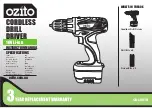
DSL-2000
4. SANDING
5. SANDING TIPS
1. Secure the material to be
sanded where possible.
2. With a firm grasp on the sander, turn the sander on.
3. Gradually lower the sander onto the workpiece with a slight
forward movement.
4. For optimum results, use either of these strokes.
Never force the sander. The weight of the sander supplies adequate
pressure, allowing the sandpaper to do the work. Applying additional
pressure will slow the motor, rapidly wear the sandpaper, and
greatly reduce the sander speed. This will slow the removal rate and
produce an inferior quality surface.
CAUTION
: Excessive pressure will overload the motor, causing
possible damage to the sander by overheating the motor; or
damage to the workpiece.
Be sure to check your workpiece often. The sander is capable of
removing material rapidly, especially with coarse paper.
The orbital action of your sander allows you to sand with the grain,
or at any angle across it for most sanding jobs. In the final stages a
better finish will be achieved by sanding with the grain.
Do not sand on one spot for too long. The sander’s rapid action may
remove too much material, creating an uneven surface.
Side to Side
Backward/ Forward













































